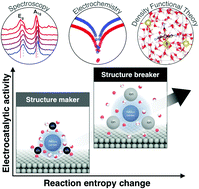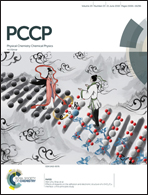Non-covalent interactions in electrochemical reactions and implications in clean energy applications†
Abstract
Understanding and controlling non-covalent interactions associated with solvent molecules and redox-inactive ions provide new opportunities to enhance the reaction entropy changes and reaction kinetics of metal redox centers, which can increase the thermodynamic efficiency of energy conversion and storage devices. Here, we report systematic changes in the redox entropy of one-electron transfer reactions including [Fe(CN)6]3−/4−, [Fe(H2O)6]3+/2+ and [Ag(H2O)4]+/0 induced by the addition of redox inactive ions, where approximately twenty different known structure making/breaking ions were employed. The measured reaction entropy changes of these redox couples were found to increase linearly with higher concentration and greater structural entropy (having greater structure breaking tendency) for inactive ions with opposite charge to the redox centers. The trend could be attributed to the altered solvation shells of oxidized and reduced redox active species due to non-covalent interactions among redox centers, inactive ions and water molecules, which was supported by Raman spectroscopy. Not only were these non-covalent interactions shown to increase reaction entropy, but they were also found to systematically alter the redox kinetics, where increasing redox reaction energy changes associated with the presence of water structure breaking cations were correlated linearly with the greater exchange current density of [Fe(CN)6]3−/4−.

- This article is part of the themed collection: 2018 PCCP HOT Articles


 Please wait while we load your content...
Please wait while we load your content...